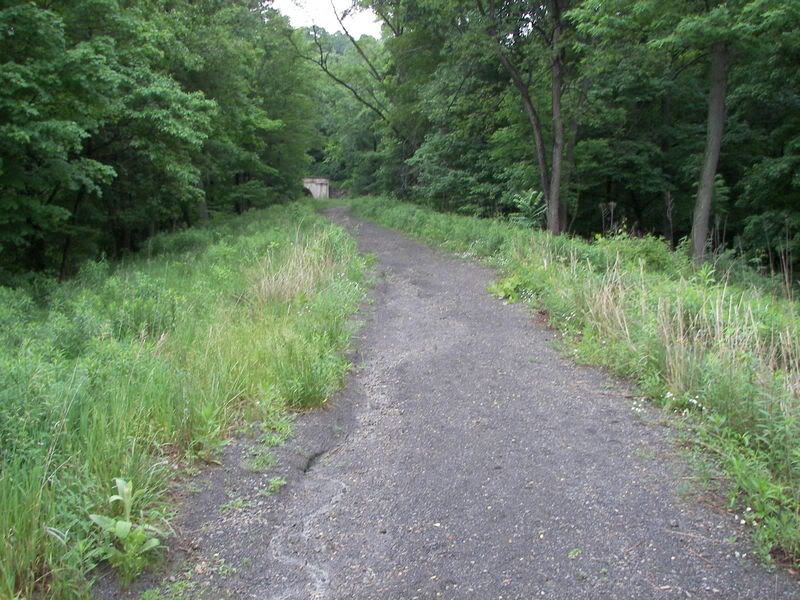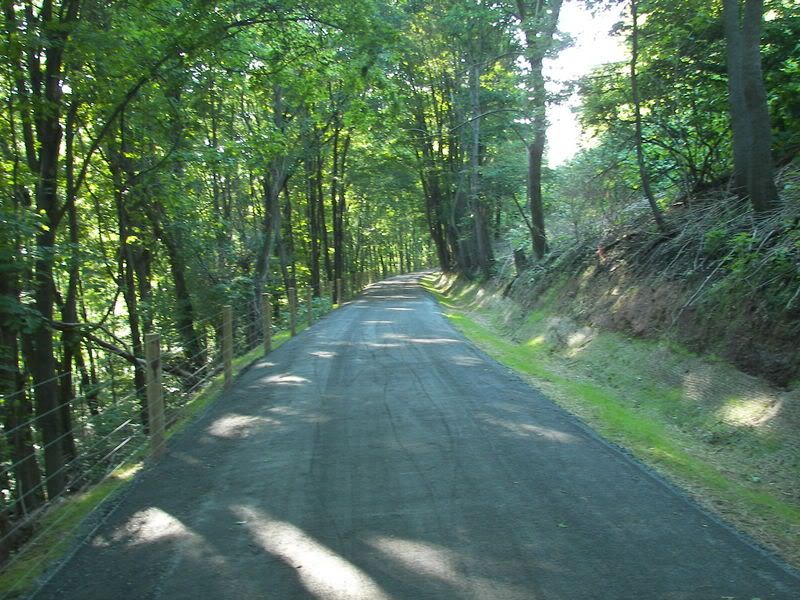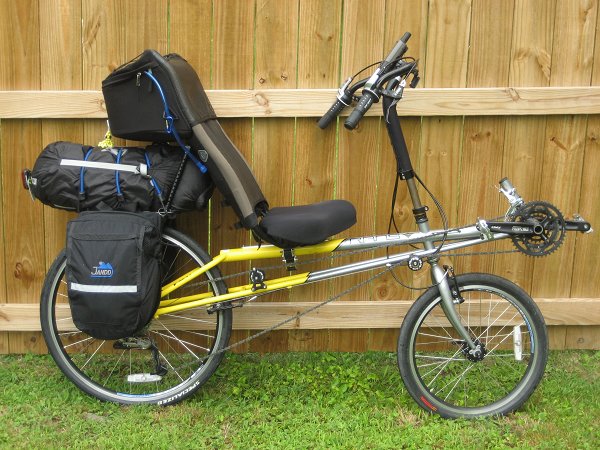Bicycling
Related: About this forumRecumbent bikes vs upright
I am getting back into bicycling and am seeking opinions. Are recumbents actually easier on the body or are they a fad? I have friends who have them and like them, but wondering if they are a fad or if they really are easier. Thanks.
angstlessk
(11,862 posts)I guess it depends on where you will be biking? Recumbents look VERY comfy...ask a friend to let you try it out...we have all rode on the regular upright bikes...
digonswine
(1,486 posts)some people are just not comfortable on them, though.
If you ride a recumbent--be sure to ride it for at least an hour or more. There is the possibility of a sore back or numbing feet due to the position. They seem super cool at first, but can get uncomfortable.
Also--you will be slower than the uprights you may ride with-especially on hills. You just don't have the torque of the upright.
My wife has a recumbent but has those problems.
Just my 2 cents.
happyslug
(14,779 posts)Most Rails to Trails Bike Trails are under 3 % Grade (Three feet rise for every 100 feet traveled) and thus no big difference on such trails. If you are going on roads in hilly country, the Upright is the clear choice for it is easier to go up hill on an upright then a recumbent. In hill country what an upright loses to a recumbent on the flats and going down hill, is more then made up going uphills. Remember the greatest loss in speed (and expenditures in energy) is in climbing hills. Thus what you gain going downhill and on the flats with a recumbent, is much less then what recumbents lose to Uprights going UPHILL.
If you plan to stay on the Rails to Trails, recumbents are on supreme, for even in hilly country railroads rarely go over 5% grade (Never if the line was ever steam, but on abandoned Streetcars right of way, 6-10% grades are possible).
When I go on the "Path of the Flood Path" I have to go up a 25% grade on road to the Path ( I Walk my upright up that grade) . I then go on a almost flat section with only a gentle curve, then downhill to Incline #1 of the old Pennsylvania Canal (1836-1854).
http://www.pecpa.org/sites/pecpa.org/files/downloads/Path_of_Flood_Final_Brochure.pdf
Incline #1 is on a 25% grade, I walk my upright going up that grade:

After the incline, you enter the Staple bend tunnel and its is almost 0% grade, followed by two miles on the old Portage railway bed, again on less the 1% grade. Then you go under the present mainline railroad and go through the little town of Mineral point then up a 15% grade to the road bed of the 1912-1927 Southern Cambria Railway (Nick Name, "The Dread of the Timid traveler"![]() .
.
The Grade up to the actual Road bed:

Once on the actual Southern Cambria rail-bed the grade varies from 5-10% with many curves. This is because Steam locomotives NEVER traveled on the Southern Cambria, it was electric driven only and electric drive could be used on steeper grades and tighter curves then Steam. On an upright, once on the Southern Cambria road bed it is doable. In the grade up to it, it is marginal for someone on a bike (you are better walking the bike to get to the trail).


As a rule, how the Path of the Flood trail in Johnstown PA is forming up, it tends to have to many grades for a recumbent, but it is alright for an upright.
I have some concerns as to Recumbent given most are quite low and Auto Drivers may NOT see them as vehicles (Many drivers have problems seeing MOTORCYCLES, let alone bicycles and recumbent are even more strange). Auto Drivers have a tendency to look for other AUTOS, missing motor cycles and conventional bicyclists in the process. I suspect recumbent would be a worse choice in that regard.
For a beginner or someone returning to biking I would opt for an upright, most are cheaper with similar components. One reason for this is Recumbent are illegal for most bicycle racing and thus not used in racing and thus not supported by most bicycle makers (who tend to see racing as a way to advertise their bicycle).
Remember this fact, the most important and expensive part of a bicycle is its frame. The better the frame the easier it will be to peddle. Components also help, but not as much as the frame and can be replaced,
20 years ago, Cannondale had a project where you could buy just the frame from Cannondale and use whatever you had at home on it. I did that and used junk components on it but then slowly replaced them as I had more money,. I notice the improvement in components made my biking easier but not as much as the switch from an old High Tension Steel Frame (the Wonder Material of 1900) to an aluminum frame (When I Upgraded to XT Shimano gearing, I was shock to find gearing that actually changed when I moved the lever to change gears, as opposed to my previous bikes when that change would take a few minutes).
The big improvement in biking is when you move up from a High Tension Steel Frame bicycle (The wonder material of 1900, had the Titanic been made of it, it would have survived the Ice berg) and Chrome Moly Frames (the wonder Material of the 1930s). Aluminum, then Titanium and now Carbon Fiber are even "Stiffer" Frames (The Stiffer the frame the easy it is to bike), but none of them are the big jump from High Tension to Chrome Moly Frame. Thus you will see all four materials being used in high end bikes (With Titanium disappearing over the last 10 years, but holding its own when it comes to components).
I ride an Aluminum and a Chrome Moly Frame bikes. The Chrome Moly is a "Racer" Style bike, the Aluminum a "Mountain" style bike, but both are about the same in Bikability.
Make sure you get a bike frame that fits you. Since you are getting "back" into biking, make sure you have a bike you WANT and can use, not something someone else tells you to buy.
My Recommendation for a new biker is to go with 700 cc "hybrid" bike with 35mm tires. It is good enough for roads and bike trails and can be use off road. If you are short go with the 24 inch frame or a 26 inch frame with 1 1/2 inch tires (if you can find them). Most mountain bikes are 26 inch based frames. The larger frame with the larger 700cc wheels makes it a better over all bike. Through presently I am riding a 26 inch frame AND a 27 inch frame (27 inch was last used by Schwinn in the 1970s, slightly larger then the 700 cc, but to my knowledge no frames are made for 27 inch wheels today, through some people call the 700 cc 27 inch).
ISO, International Standard Organizations have adopted a system of bike sizes, but no one uses them for marketing, for a 700 cc wheel sounds better then a 622, a 26 inch wheel sounds better then a 599 wheel:
Popular sizes and their ISO names:
700cc is also called a 622 wheel (622 is the actual measurement of the Wheel not the nominal tire on that wheel).
26 inch is also called a 599 wheel
27 inch is also call a 630 wheel
More on Tires:
http://sheldonbrown.com/tire-sizing.html
Here is Sheldon Brown on Recumbents:
http://sheldonbrown.com/recumbents.html
Kolesar
(31,182 posts)The frames have shorter tubes and there is way less energy lost to the flexing of the frame. I think they are much more fun .
With an upright bicycle, you can put your weight over the pedals and mash your way up a hill in a way you cannot do in a recumbent. When I rode on a tour I noted that I could outclimb the recumbents on even the slight hills. As others have said, if you ride on flat trails, it won't matter.
Recumbents are fun, though. You can certainly ride all day without soreness.
If you are concerned about aching wrists and aching butt, follow Sheldon Brown's advice and slowly train your way up to longer distances. He had almost absurd advice of riding five minutes on your first ride, but it makes some sense. If one is untrained and gets tired on a long ride, one sets more weight on the saddle and the handlebars. Hence, one gets sore.
One problem with recumbents is that is hard to get them onto a car rack.
Try one of each and decide.
Fumesucker
(45,851 posts)After about five years on a recumbent I just don't feel ~safe~ on a standard bike any more. If I go down on my bent, which I have twice now, I hit on my butt and slide feet first toward whatever, I'm also at a good bit lower height than on a standard Diamond Frame bike so I don't hit as hard. Go down on a DF bike and you are likely to be going head first and you're going to hit with your head and hands, elbows and so on, I've done that enough times in my life that I have lost count.
Another reason I feel safer on a bent is that cars tend to give you a lot more room than on a DF bike, I'm far from the only one to notice this, I've read quite a few comments from other bent riders that indicate that car drivers are less aggressive with them on the bent than on a DF bike.
Particularly if you want to ride for longer distances at slightly lower speeds a bent is good. If you have back, neck, wrist or shoulder issues a bent may be a good choice for you. If you are in a moderate reclining position then visibility forward and to the sides is excellent, you will want rear view mirrors though because looking over your shoulder is more difficult.
The single hardest part of riding a bent is starting off uphill, pushing hard enough on one pedal to get enough momentum to pick the other foot up and get it on the pedal and continue the motion takes some practice and you have to be in the right gear before you start pedaling which means you have to get in the right gear before you stop.
jberryhill
(62,444 posts)They are nearly as rare as unicorns in my neck of the woods, and I've never found anyone who rents them.
I'd love to give one a whirl someday.
Do you ever carry your recumbent bike on a car carrier of any sort?
I also have to store my bike up a small set of steps, and I understand they are quite heavy.
Fumesucker
(45,851 posts)It's not much heavier than a standard DF bike, the frame is a very thin walled aluminum extrusion and I find it easy to carry by picking it up just in front of the seat where it stays fairly balanced. I usually pick it up with my right hand and steady the steering column with my left, no need to heave it up since the wheels are about a foot off the ground with your carrying arm straight.

Since I posted in Feb I have bought another recumbent from Craigslist, a DH1000 which is a Rans-style long wheelbase. It's long enough that it would be a bit awkward carrying it up stairs but the weight isn't that much of an issue at least for me. Getting it on a car carrier would probably be fairly easy but it would stick out past the sides of the car most likely. On the other hand the ride is superb, the chrome moly frame is supple enough to absorb quite a bit of vibration and the geometry is such that it's more stable at both low and high speeds than the bikeE. It's really the seat which makes the biggest difference in weight between many recumbents and DF bikes, you just can't make a lounge chair as light as a postage stamp sized bar stool. The frame on the DH1000 doesn't have all that much more tubing than a DF bike and the other components are basically the same (Shimano Deore with old school friction shifters).
My DH1000 was also made in the USA (Texas) while the bikeE was made in Taiwan.

I wanted to get a short wheelbase bent but couldn't find one during the winter in my lowish price range, the Rans V-Rex is a good example of a SWB bent and the reviews seem to be uniformly positive. The V-Rex would easily fit on a car carrier and I don't think carrying it up stairs would be a problem either.

As for climbing on a bent, if you are a spinner rather than a masher you'll do better, my knees are fine with spinning but hurt if I try to mash so it works for me. In fact I'd like to get a set of cranks more like 140mm or so than the standard 170-ish so I could spin even faster in a lower gear. It is possible to push from your hips and shoulders and mash your way over rolling hills but it takes quite a while to learn to do it as naturally as standing on the pedals and as I say it makes my knees hurt.
I'm starting to think that the taller you are the more sense a bent makes, tall riders on a DF bike have more aerodynamic resistance than a shorter rider but height makes much less drag difference on a bent. A tall rider on a DF bike also has a higher center of gravity and is more likely to go over the bars in a crash or hard braking maneuver.
jberryhill
(62,444 posts)I don't have a problem with increasing cadence and going slow up hills.
I notice that all of the pictures you've shown have the handlebars up front. Have you tried the configurations where the grips are beneath seat level. I had read somewhere that reaching up to the grips gets to feel like riding a chopper after a while. Or is it not a big deal either way?
Fumesucker
(45,851 posts)That probably wouldn't be the best choice for a first bent, too many unfamiliar cues at one time I would think.
Those who like them seem to like them a lot though, once you get used to the laid back position I don't think it would be a big deal to move your hands down by your sides and I can see how it could be very comfortable and natural feeling eventually.
I like the hand position on both of my bikes although I wouldn't be surprised if they could be improved with some individual adjustments. The bikeE bars move up and down a considerable distance, I keep them just high enough they clear my knees with a bit of extra for tight turns. I have a Princetontek headlight on my bars I keep in flashing mode during the day, I also have an Airzound air horn on my bars so I wouldn't want to give up the high mounted handlebars just for those two items.
On a mountain style bike I have problems with hand numbness these days, it only takes a few minutes of riding until my palms and fingers start to tingle from the pressure. I haven't ridden drop bars on a real road bike in a long time but that would probably bother my hands too now.
I came close to pulling the trigger on a Bachetta Agio this winter but it was too far away to make picking it up really practical and the seller didn't want to ship it.

Portland Cyclist
(29 posts)I like the commanding view I get from my upright. Also it's nice to have the option of sitting down or standing up.